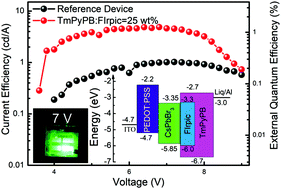Boosting the external quantum efficiency in perovskite light-emitting diodes by an exciton retrieving layer†
Abstract
Perovskite light-emitting diodes (PeLEDs) are promising next-generation light sources due to the excellent optical and electronic properties of the materials as well as their process simplicity and low cost. To boost their electroluminescence (EL) efficiency, a plethora of approaches are proposed and demonstrated. Here, another possibility by introducing an exciton retrieving layer (ERL) into the devices is reported. A composite layer, formed by vacuum co-evaporating an electron transporting material (1,3,5-tri(m-pyrid-3-yl-phenyl)benzene, TmPyPB) and a blue phosphorescent material (bis(2-(4,6-difluorophenyl)-pyridinato-N,C2′)picolinate, FIrpic), is inserted into PeLEDs as an ERL in between the emitting layer and the electron transporting layer. Both 3D and quasi-2D PeLEDs with an ERL exhibit strongly enhanced EL performance without changing the emission spectra. 3D PeLEDs show a low turn-on voltage of ∼3.6 V, a maximum luminance of 14 363 cd m−2, and a maximum external quantum efficiency (EQE) of 1.26%, which correspond to 2.5-fold luminance and 3.8-fold EQE enhancements compared with the control device. Quasi-2D PeLEDs exhibit a low turn-on voltage of ∼3.6 V, a maximum luminance of 9481 cd m−2, and a maximum EQE of 4.24%, corresponding to a 2.7-fold EQE enhancement compared with the control device. The physical mechanism is further discussed theoretically and validated experimentally. The blue phosphorescent FIrpic can act as a sensitizer such that energy can be transferred from both the singlet and triplet excitons of TmPyPB to the excited states of CsPbBr3via Förster and Dexter energy transfer processes.



 Please wait while we load your content...
Please wait while we load your content...